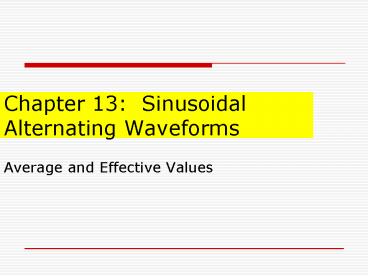Chapter 13: Sinusoidal Alternating Waveforms - PowerPoint PPT Presentation
1 / 13
Title:
Chapter 13: Sinusoidal Alternating Waveforms
Description:
For a periodic waveform sum the blocks of area and divide by total time. ... Some meters only measure sinusoidal rms accurately. More expensive meters are true rms ... – PowerPoint PPT presentation
Number of Views:151
Avg rating:3.0/5.0
Title: Chapter 13: Sinusoidal Alternating Waveforms
1
Chapter 13 Sinusoidal Alternating Waveforms
- Average and Effective Values
2
Average Value
- In general for average,
- Add all the values
- Divide by number of values
- 5 3 4 12
- 12 /3 4
- Now apply this idea to a time varying signal.
3
Average Value
- The average value of a curve is the area under
the curve divided by the length of the curve. - For a periodic waveform sum the blocks of area
and divide by total time. - dc meter measures average value!
4
Average Value Example
1v
3s
1s
2
5
Sinusoid Average Value
- Average value of one period is zero!
- There is as much area above zero amplitude as
below for one cycle. - dc meter reading of a sinusoid is zero. (without
offset).
6
Half Wave Sinusoid Average Value
7
Effective Values
- Although the average value of a sinusoidal
current is zero, the current still does work
regardless of direction. - An ac current through a resistor will make the
resistor hot. How hot? - Compare heating effect to that produced by a dc
source. - Call that ac value the effective current.
8
Effective Current
What ac current, i, will produce the same average
power (heat) to the resistive load as the dc
current, I?
RLoad
RLoad
I
i
9
Power to Resistor
10
Power to Resistor
- The average value of a sinusoid is zero. So the
average power is - Since the sinusoidal part has zero average.
The same relationship is true for effective
voltage.
11
Power Considerations
zero average
non zero average
Power to a resistor is a squared function so
always positive average.
12
General Effective Values
1. Square the function. 2. Find the average
value of the squared function. 3. Take the square
root to find the effective value. Effective value
is then called root-mean-square or rms value.
13
ac Meters and Instruments
- ac multimeter is calibrated to measure rms.
- Some meters only measure sinusoidal rms
accurately. - More expensive meters are true rms and will
accurately measure the effective value of any
waveform.































